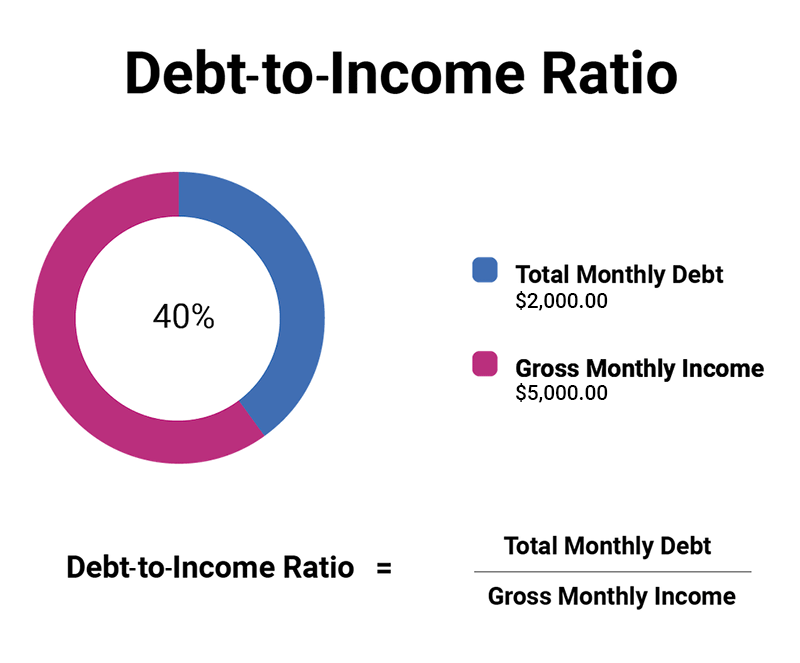In this article:
Your debt-to-income ratio (DTI) is an important measure lenders and creditors use to evaluate how easily you can take on a new debt payment. Your debt-to-income ratio measures the percentage of your gross monthly income that goes toward paying your debts.
Let's say you apply for a mortgage with a $1,500 monthly payment. In this case, lenders would use your DTI to make sure there's adequate cushion in your budget after debt payments to absorb the new $1,500 payment with your current monthly income.
Lenders use DTI and other aspects of your financial profile—like your credit history—to evaluate whether to give you a new loan. Before you apply for new credit, it's essential to understand how to calculate your DTI, what this ratio reveals about your financial standing and how to lower your DTI.
How Do I Calculate My Debt-to-Income Ratio?
Your DTI is a simple calculation that compares your monthly debt obligations with your gross monthly income. Calculating your DTI ratio can be done in three steps:
- Add together your total monthly debt payments. Add up all your monthly bills, including mortgage or rent, auto loans, student loans, credit cards and any alimony and child support payments. Note that groceries, utilities and health care costs are not usually included in DTI calculations.
- Divide your total monthly debt payments by your gross income. Gross income is your pay before taxes and other deductions are taken out.
- Multiply the resulting number by 100 to express your DTI as a percentage. The lower your DTI, the better your odds of approval for new credit.
Let's suppose the total of your recurring monthly bills is $2,000, and your gross monthly income is $5,000. In this case, you can determine your DTI by dividing your total monthly debt obligation ($2,000) by your gross income ($5,000), which is 0.4. Complete the calculation by multiplying that number by 100 to convert it to a percentage, or 40% (0.4 x 100 = 40).
In this situation, the DTI shows potential lenders that 40% of your gross monthly income goes toward debt payments each month, and 60% is left over for other expenses.

Why Does My Debt-to-Income Ratio Matter?
Your debt-to-income ratio matters for a few important reasons:
Lenders Use Your DTI to Make Loan Approval Decisions
Lenders use their knowledge of DTIs to predict when a customer might have financial difficulty making payments. They also use DTIs—along with your credit score, income and other factors—to determine lending amounts.
A high DTI indicates you have a lot of debt and may struggle to make a new loan payment. Consequently, a higher debt-to-income ratio makes it harder to qualify for new credit or to receive a lower interest rate.
DTI Can Affect Types of Loans You Get
Lenders often follow debt-to-income ratio guidelines for specific types of loans. So, for example, if your DTI ratio is 40%, you might not qualify for a conventional mortgage loan from a lender that caps its DTI limit at 36%. However, you may qualify for an FHA loan with a lender that follows the Federal Housing Administration's debt ratio limit guideline of 43%.
High Debt-to-Income Ratio Can Make It Harder to Achieve Financial Goals
The more debt you carry, the less disposable income you have to put toward your emergency fund, retirement plan or other financial goals. If you spend more than 50% of your monthly income on debt payments, you may want to work to lower your debt.
Consider following a debt repayment strategy like the debt avalanche method or debt snowball method to eliminate your debt. Lowering your debt-to-limit ratio will add breathing room to your budget and make it easier to qualify for loans with better loan terms.
What Is a Good Debt-to-Income Ratio?
Short answer: A good debt-to-income ratio is one that is as low as possible. A low DTI may improve your approval odds for loans and credit cards with low interest rates.
Keep in mind, different lenders follow different eligibility criteria, and their DTI ranges often vary. An "ideal" DTI for one lender may be a dealbreaker for another, and vice-versa.
Still, many lenders want your DTI to meet specific debt limits for different types of loans.
- Conventional mortgage loans: Most lenders require your DTI to fall below 43%, though some prefer a DTI of 36% or lower for a conventional mortgage. You may be eligible with a DTI ratio as high as 50% if you have a high credit score, assets like cash reserves or additional income.
- Non-conventional mortgages: Government-backed loans from the Federal Housing Administration (FHA) and the Department of Veterans Affairs (VA) follow their own debt-to-income ratio guidelines. FHA loans call for a front-end ratio—how much of your gross monthly income is spent on housing costs—of no more than 31% and a back-end ratio of 43% or less. VA guideline for an acceptable debt-to-income ratio for a VA loan is 41%. Of course, some lenders may require a lower DTI ratio, while others may permit a higher DTI.
- Personal loans: You'll typically need a DTI of 35% to 40% or less, although you may qualify with a higher DTI if your credit is strong.
- Auto loans: With a high credit score, you may only need proof of employment and income to qualify for a car loan. As a general rule, however, it's best to maintain a debt-to-income ratio below 43%.
How Can I Lower My Debt-to-Income Ratio?
Your DTI is one of several factors lenders and creditors consider when deciding whether to approve your credit application. Still, you may enjoy more credit options and lower interest rates with a low DTI. To lower your DTI, work to improve both halves of the equation: increasing your income and decreasing your debt.
Increase Your Income
Adding more income to your budget can help you tackle debt and quickly lower your DTI. Here are some ways to increase your monthly income.
- Volunteer for overtime at work. Working even a few extra hours at a higher overtime rate, typically an extra 50% of your hourly rate, can significantly upgrade your income.
- Negotiate with your employer for a raise. If your pay falls below the market rate for your job, request a wage increase and be prepared to state why you're worth it.
- Get a higher-paying job or take on a second job. If a wage increase isn't possible, consider working for another employer at a higher pay rate or taking on a second job after hours.
- Start a business or side hustle. According to a Neighbor.com survey, 60% of Americans with side gigs earn up to $500 monthly, while 11% earn $501 to $1,000 each month. While you may not get rich with a side hustle, you could use the money to pay down your debt quickly.
Decrease Your Monthly Debt Burden
To decrease your overall debt, review your budget to identify funds that can be redirected to pay your debt down.
- Pay off existing debts. Apply extra payments towards the principal on a loan or credit card account to accelerate your debt payoff time frame.
- Reduce your expenses. Consider cutting little-used memberships, subscriptions and other forms of discretionary spending and put the extra money toward getting out of debt.
- Increase your loan term. Extending the repayment term on a loan can lower your payment and, consequently, your DTI. However, having a longer term means you'll likely pay more in interest charges over the life of the loan.
- Avoid adding more debt. Opening new credit accounts will add to your monthly debt payments and could offset any progress you make to reduce your DTI.
Lowering Your Debt Burden Could Positively Impact Your Credit
Reducing your total debt amount can lower your debt-to-income ratio, and it can also lower your credit utilization ratio and positively affect your credit. Credit utilization ratio is the amount of available revolving credit you're currently using, and it accounts for about 30% of your FICO® Score☉ . So if you've charged $500 on a credit card with a $2,000 limit, your credit utilization ratio is 25% (500/2000 = 0.25). Experts often recommend keeping your credit utilization rate below 30%, but the lower, the better.
Like a low debt-to-income ratio, a high credit score can improve your odds of approval for new credit. One way you can try to improve your credit score for free is with Experian Boost®ø, which gives you credit for paying your utilities, cell phone and streaming services.

